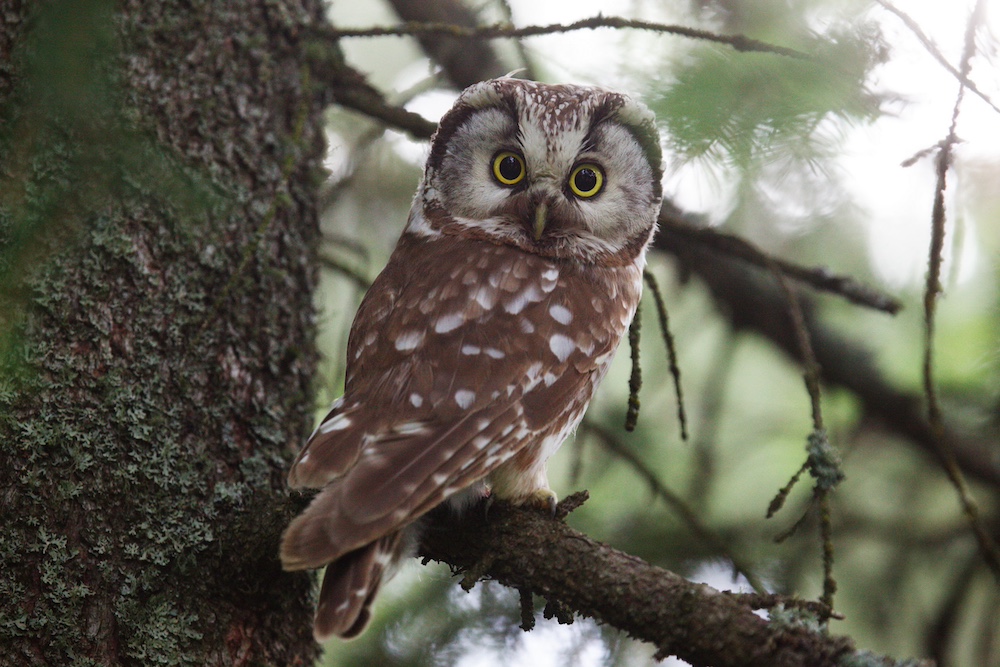Breeding ecology of Boreal Owl Aegolius funereus in Jämtland, central Sweden, 1976–1985
DOI:
https://doi.org/10.34080/os.v34.23521Keywords:
long-term study, nest box, bigyny, predation, Martes martes, rodent densityAbstract
A long-term Boreal Owl Aegolius funereus nest box project ran 1976–1985 in central Sweden. Average occupancy among 200 nest boxes was 16% (range 0–54%) with average clutch size 6.0 eggs and number of fledged per successful breeding 4.6, while 41% of breeding attempts failed, primarily due to predation by pine marten Martes martes or desertion by the female. The highest observed breeding density was 0.9 breedings/km2. Five cases of bigamy were observed. Females weighed 50% more than males during egg laying and incubation, probably because of pre-emptive weight gain to compensate for the risk of subsequent changes to food availability. The male provisioned both the female and chicks for most of the breeding period, mainly with small rodents (87%). Population sizes of small rodents fluctuated in 3–4-year cycles. Reproduction was successful during phases of increasing rodent density (1977–1978, 1980–1981, and 1984–1985), while almost no breedings were initiated during nadir years (1976, 1979, and 1982–1983). Ringing recoveries suggested that juveniles recruited into the local population in years with abundant food resources, but dispersed if food availability was declining. Adult females were often nomadic, while most males were resident.
Downloads
References
Carlsson B-G. 1991. Recruitment of mates and deceptive behaviour by male Tengmalm’s owls. Behavioral Ecology and Sociobiology 28: 321–328. https://doi.org/10.1007/BF00164381 DOI: https://doi.org/10.1007/BF00164381
Carlsson B-G, Hörnfeldt B & Löfgren O. 1987. Bigyny in Tengmalm’s Owl Aegolius funereus: effect of mating strategy on breeding success. Ornis Scandinavica 18: 237–243. https://doi.org/10.2307/3676890 DOI: https://doi.org/10.2307/3676890
Carlsson B-G & Hörnfeldt B. 1994. Determination of Nestling Age and Laying Date in Tengmalm’s Owl: Use of Wing Length and Body Mass. Condor 96: 555–559. https://doi.org/10.2307/1369336 DOI: https://doi.org/10.2307/1369336
Christensen B. 1986. Et sammenlignende studie av pärleuglens (Aegolius funereus) og högeuglens (Surnia ulula) föde i Jämtland, Sverige. Mitthögskolan Östersund.
Eldegard K & Sonerud GA. 2009. Female offspring desertion and male-only care increases with natural and experimental increase in food abundance. Proceedings of the Royal Society B 276: 1713–1721. https://doi.org/10.1098/rspb.2008.1775 DOI: https://doi.org/10.1098/rspb.2008.1775
Hipkiss T. 2002. Sexual size dimorphism in Tengmalm’s owl (Aegolius funereus) on autumn migration. Journal of Zoology 257: 281–285. https://doi.org/10.1017/S0952836902000870 DOI: https://doi.org/10.1017/S0952836902000870
Hipkiss T, Hörnfeldt B, Lundmark Å, Norbäck M & Ellegren H. 2002. Sex Ratio and Age Structure of Nomadic Tengmalm’s Owls: A Molecular Approach. Journal of Avian Biology 33: 107–110. https://doi.org/10.1034/j.1600-048X.2002.330118.x DOI: https://doi.org/10.1034/j.1600-048X.2002.330118.x
Holmberg T. 1980. Polygyny in Tengmalm’s Owl Aegolius funereus. Vår Fågelvärld 39: 405.
Holmberg T. 1982. Om pärlugglans ekologi. Vår Fågelvärld 41: 265.
Hörnfeldt B. & Eklund U. 1990. The effect on food on laying date and clutch size in Tengmalm’s owl. Ibis 132: 395–406. https://doi.org/10.1111/j.1474-919X.1990.tb01058.x DOI: https://doi.org/10.1111/j.1474-919X.1990.tb01058.x
Hörnfeldt B, Hipkiss T & Eklund U. 2005. Fading out of vole and predator cycles? Proceedings of the Royal Society B 272: 2045–2049. https://doi.org/10.1098/rspb.2005.3141 DOI: https://doi.org/10.1098/rspb.2005.3141
Kondratzki B & Altmuller R. 1976. Bigynie beim Rauhfusskauz (Aegolius funereus). Vogelwelt 97: 146–149.
Korpimäki E. 1986. Reversed size dimorphism in birds of prey, especially in Tengmalm’s Owl Aegolius funereus: a test of the “starvation hypothesis”. Ornis Scandinavica 17: 326–332. https://doi.org/10.2307/3676820 DOI: https://doi.org/10.2307/3676820
Korpimäki E & Hakkarainen H. 2012. The Boreal Owl: Ecology, Behaviour and Conservation of a Forest-Dwelling Predator. Cambridge University Press, Cambridge. DOI: https://doi.org/10.1017/CBO9780511844164
Lundberg A. 1979. Residence, migration and a compromise; adaptations to nest-site scarcity and food specialization in three Fennoscandian owl species. Oecologia 41:273-281 DOI: https://doi.org/10.1007/BF00377431
Löfgren O, Hörnfeldt B & Carlsson B-G. 1986. Site tenacity and nomadism in Tengmalm’s Owl (Aegolius funereus) in relation to cyclic food production. Oecologia 69: 32–-326. https://doi.org/10.1007/BF00377051 DOI: https://doi.org/10.1007/BF00377051
Magnusson M, Hörnfeldt B & Ecke F. 2015. Evidence for different drivers behind long-term decline and depression of density in cyclic voles. Population Ecology 57: 569–580. https://doi.org/10.1007/s10144-015-0512-3 DOI: https://doi.org/10.1007/s10144-015-0512-3
Mikkola H. Owls of Europe. 1983. T & AD Poyser, Calton.
Newton I. 1979. Population Ecology of Raptors. T & AD Poyser, Berkhamstead.
Naturvårdsverket 2020. Klimatfakta: Klimatet i framtiden: Effekter i Sverige. https://www.naturvardsverket.se/amnesomraden/klimatfakta/klimatet-i-framtiden/effekter-i-sverige/
Ottosson U, Ottvall R, Elmberg J, Green M, Gustafsson R, Haas F, Holmqvist N, Lindström Å, Nilsson L, Svensson M, Svensson S & Tjernberg M. 2012. Fåglarna i Sverige – antal och förekomst. Sveriges Ornitologiska Förening, Halmstad.
Schwerdtfeger O. 1984. Verhalten und Populationsdynamik des Rauhfusskauzes (Aegolius funereus). Vogelwarte 32: 183–200.
Sonerud GA. 1985. Nest hole shift in Tengmalm’s Owl Aegolius funereus as defence against nest predation involving long-term memory in the predator. Journal of Animal Ecology 54: 179–192. https://doi.org/10.2307/4629 DOI: https://doi.org/10.2307/4629
Sonerud GA. 1985. Risk of Nest Predation in Three Species of Hole Nesting Owls: Influence on Choice of Nesting Habitat and Incubation Behaviour. Ornis Scandinavica 16: 261–269. https://doi.org/10.2307/3676689 DOI: https://doi.org/10.2307/3676689
Sveriges Meteorologiska och Hydrologiska Institut. Sveriges Klimat 2021. https://www.smhi.se/kunskapsbanken/klimat/sveriges-klimat

Downloads
Published
How to Cite
Issue
Section
License
Copyright (c) 2024 Thomas Holmberg

This work is licensed under a Creative Commons Attribution 4.0 International License.
The copyright of each contribution belongs to the author(s), but all contributions are published under a Creative Commons license, so that anyone is free to share and reuse the contribution as long as the copyright holder is attributed.







